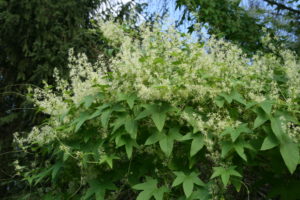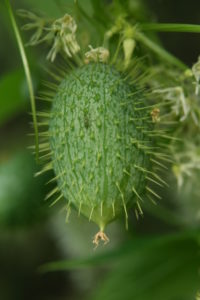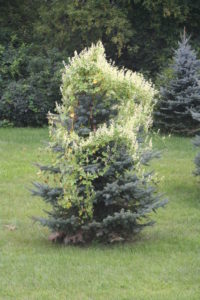Have you noticed a fast-growing vine with fragrant flowers on your trees and shrubs this summer? The plant began to flower a few weeks ago, drawing attention and concern from residents around the state.

Wild cucumber blooms in mid- to late summer with yellowish-white fragrant flowers. Credit: Susan Mahr.
Wild cucumber, or Echinocystis lobata, is a fast-growing annual species that reproduces from seed each year. It can quickly grow up to 30 feet long and produces tendrils that wrap around other plants and structures for support. It is a native but aggressive plant that grows extremely well during wet summers like the one we’ve had this year.
The seed pods produced by this plant are covered with long, soft spines and are hollow. Eventually the exterior tissues of the fruit disintegrate, leaving behind a structure that looks like a sponge. Please note that while wild cucumber may appear similar to a garden cucumber, it is not an edible plant and can even cause burning reactions in some people.

Wild cucumber fruits are small, green and covered with soft spines. Credit: Susan Mahr.
This plant does not cause direct damage to trees or shrubs but it can cover leaf surfaces, leading to reduced photosynthesis and growth. This is primarily a concern in landscape settings, where an individual plant might be overtaken by the vine. In a natural forest setting, this plant does not pose a significant threat to forest health or function.

This vining plant can be damaging to individual trees and shrubs but poses little concern in forest settings. Credit: Susan Mahr.
Anyone concerned about wild cucumber impacting yard trees and shrubs can take simple measures to remove it. As a weak-rooted plant, it is easy to pull away from affected vegetation. It can also be cut away near the base. Chemical control is not necessary but if you decide to use an herbicide, follow the product label carefully and always use protective equipment. Take care to avoid spraying the tree or shrub that the cucumber is using for support.
Remove wild cucumber now before it sets fruit. Once mature, the fruits will burst at the bottom to expel four black or brown seeds that germinate after the last frost.
For more information and photos of this species, read this article from Susan Mahr with the UW-Madison Master Gardener Program.
